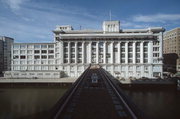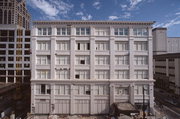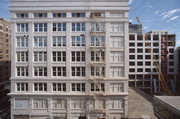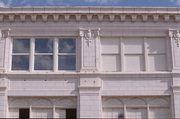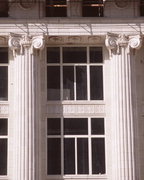Property Record
101 W WISCONSIN AVE (AKA 600-648 N PLANKINTON)
Architecture and History Inventory
| Historic Name: | GIMBELS DEPARTMENT STORE |
|---|---|
| Other Name: | MARSHALL FIELD'S BUILDING |
| Contributing: | Yes |
| Reference Number: | 16193 |
| Location (Address): | 101 W WISCONSIN AVE (AKA 600-648 N PLANKINTON) |
|---|---|
| County: | Milwaukee |
| City: | Milwaukee |
| Township/Village: | |
| Unincorporated Community: | |
| Town: | |
| Range: | |
| Direction: | |
| Section: | |
| Quarter Section: | |
| Quarter/Quarter Section: |
| Year Built: | 1901 |
|---|---|
| Additions: | 1919 1984 1923 |
| Survey Date: | 2004 |
| Historic Use: | large retail building |
| Architectural Style: | Neoclassical/Beaux Arts |
| Structural System: | |
| Wall Material: | Brick |
| Architect: | Daniel H. Burnham & Co.; Herman J. Esser |
| Other Buildings On Site: | |
| Demolished?: | No |
| Demolished Date: |
| National/State Register Listing Name: | West Side Commercial Historic District |
|---|---|
| National Register Listing Date: | 12/22/2000 |
| National Register Multiple Property Name: |
| Additional Information: | A 'site file' exists for this property. It contains additional information such as correspondence, newspaper clippings, or historical information. It is a public record and may be viewed in person at the State Historical Society, Division of Historic Preservation. Another map code is 4/20 LUQS #397. Herman J. Esser of Milwaukee was the builder. ARCHITECTURAL SIGNIFICANCE: Eight-story classicized Commercial Style building in white glazed brick and terra cotta. Built in stages, the first of the complex rose on Wisconsin Ave. from the plans of the well-known Chicago firm of Daniel H. Burnham and Co. Alteration to the original structure, plus additions on Michigan Street, were made in 1919. The striking colonnaded riverfront section dates from 1923-1925. It was designed by Herman J. Esser and modeled after Self-ridges Department Store of London. HISTORICAL SIGNIFICANCE: Gimbels has been an important retail establishment in downtown Milwaukee since 1887. The following excerpt from DOWNTOWN MILWAUKEE summarizes the firm's history: "Gimbels traces its history to 1842, when Adam Gimbel settled in Vincennes, Indiana, and opened a shop called the Palace of Trade. The enterprise prospered, and eventually Adam brought his seven sons into the business. By 1875, the family firm employed over forty salespersons, and a large sign on their new building proclaimed the Gimbels 'champions of low prices.' Vincennes, a prominent river port, declined as the railroads advanced, and so in 1887, the firm moved west to Milwaukee, rented a building from John Plankinton, and opened the first Gimbels on Wisconsin Avenue. The department store expanded to adjoining buildings during the next decade, and by 1901, construction of the present complex was under way." MILWAUKEE LANDMARKS COMMISSION: Description: The present Gimbels downtown store results from the combination of several structures, each built during a different period in the life of Gimbels and the city of Milwaukee. The proud Wisconsin Avenue and Milwaukee River facades present a consistent architectural face, concealing six different buildings, built between the mid-nineteenth century and the 1920s. Wisconsin and Plankington facades, framed with cast-bronze (?) surrounds. The bays of the first and subsequent floors are defined by terra-cotta clad pilasters, which contain a window grouping that consists of two movable sashes flanking a fixed light. The first two floors are united through a full entablature located at the top of the second floor. The third story is similar to the second, sharing the same bay divisions and window arrangements, yet has a rusticated terra-cotta skin. Floors four through eight return to the smooth terra-cotta of the first two floors and between the seventh and the eighth floors is a low relief architrave that acts as a string course. The eight floor windows are smaller than those on the other floors, located between the aforementioned string course and the heay cornice above. A parapet completes the building. The #2 building, built between 1914-1915, and designed by Herman J. Esser, is located at the northeast corner of Plankington and Michigan. Originally four stories, and later increased to six, the building was constructed on the site of the old Commission (produce) houses and the Star Burlesque Theater. The ordering of the facades and the materials used are similar to those on building #1. Building permits for February 10 and September 10, 1919 record the construction of the seven story #3 building, located on the Milwaukee River at Michigan Avenue. The $160,000 structure, also designed by Herman Esser, completed Gimbels' occupancy of the entire block, bounded by the Milwaukee River and Wisconsin, Plankington, and Michigan Avenues. #3 is similar to buildings #1 and #2. In addition, the top two stories of the #2 were built at the time of #3's construction. Gimbels' eight story river facade (#4), reportedly based upon D.H. Burnham's 1909 design for London's Selfridge department store, was begun in October of 1923 (Permit #30218). Framed in steel with floors of reinforced concrete and brick curtain walls clad in glazed terra-cotta, this important Milwaukee landmark was also designed by H.J. Esser, at the cost of $215,000. Accommodating a river walk alongside its base, this eight story building is dominated by engaged columns of a composite order, reaching four stories in height and extending for twelve bays. These are supported upon the first two stories, which act as a plinth. The first and second floor facades are divided by pilasters, instead of engaged columns, into bays which are infilled by windows. Small windows are located in random bays on the first floor and a three part Chicago window is used for the second floor. Floors three through six have four metal frame windows per bay as well as bronze spandrels defining floor levels. The seventh floor is located in the architrave and frieze that spans the riverside colonnade and contain two double-hung windows in each bay. The pilasters dividing these bays are decorated with a medallion or garland motif. The Gimbel Brother's first Milwaukee store opened on September 27, 1887 and was located at #3-5 Grand (West Wisconsin) Avenue, one building west of the river on the site now occupied by Gimbels' Wisconsin Avenue facade. It is appropriate to briefly describe this original store, locating it as a benchmark on the block from which the Gimbel brothers based their success, not only for their Milwaukee operations, but also those to follow in Philadelphia and New York. #3-5 Grand, the tallest building on that side of the block, was owned by John Plankington, a prominent Milwaukee businessman and meatpacker, and previously occupied by "The Fair" dry goods store. The four story, 30'x100' building was three bays wide and of masonry construction. Two display windows, flanking the entry bay, opened to Grand Avenue and the building was capped by a heavily corbelled cast iron cornice, topped with a finial. Gimbels' first addition occurred to the south in the early 1890's, when buildings located along 174-176 West Water (Plankington) Street were occupied. These were four stories tall and divided into 10 bays, with each bay being three windows wide. At street level, large display windows were used, while all other floors had 1/1 wooden frame, double-hung windows, providing necessary illumination to the interior. All windows had flat head pieces, except for a few basket-handle arch heads. This row of store fronts was terminated by a heavy cast-iron cornice with large mutule blocks. this building still exists, however, the entire facade has been covered with a smooth plaster surfacing, ostensibly to better match the newer terra-cotta buildings around it (1941). The Brothers next expanded into a five story structure bounded on one side by the west bank of the Milwaukee River. Photographs reveal it to be a straightforward building of brick bearing wall with a regular fenestration pattern. It was removed for the 1923 construction of current colonnaded building along the river. In 1898 the Gimbel Brothers' neighbor, Henry Wehr, whose restaurant was located on the corner of the Milwaukee River and Grand Avenue, moved his operations directly across the street, enabling the store to expand eastward to the river. This brick building, originally #1 Spring Street, dated to before the Civil War. It was four stories tall, one bay wide (consisting of three windows) and five irregular bays long. All windows were wood frame double-hungs with round heads surmounted by a round drip molding. Both this building and the five story structure immediately south of it (see above) were demolished in the 1920s for Gimbels' new river buildings. In April of 1902, demolition of the three story buildings on the south-east corner of Wisconsin and Plankington began, soon followed by the construction of building #1. Opened in October, 1902, the eight story structure was designed by the noted firm of D.H. Burnham and Co. of Chicago. The eighth floor is above the monumental cornice and has a row of small eave-line windows immediately below a sloping roof. The facade is completed by a penthouse situated in the middle of the building. Significance: The seven Gimbel brothers opened their Milwaukee store in September of 1887 in a building (#3 & 5 Grand Avenue) carefully located in a downtown business area. The prosperous and innovative department store grew out of Adam Gimbel's "Palace of Trade," established in 1842 in the small river town of Vincennes, Indiana. Adam, the father of the seven Gimbel brothers, was a German immigrant and began his merchandizing career as an itinerant peddler soon after landing in New Orleans in 1835. After establishing a solid clientele in Milwaukee, the brothers went east, opening stores in Philadelphia (1894) and New York (1910). They also acquired and developed the highly successful Saks Fifth Avenue stores. Keen business acumen, conscientious service, and continual innovation characterized the management of the Gimbel brothers. They were first in the Milwaukee area to offer electric elevators, an automatic cash and parcel service, motorized package delivery and the area's first charge account system. Significantly, the first radio station in the area originated from and was sponsored by Gimbels. The store has contributed enormously to the city's growth, and achieved nationwide fame as a commercial retailer offering quality goods and services. The architect of the 1901 building (#1), located at the southeast corner of Wisconsin and Plankington, was the nationally renowned firm of D.H. Burnham and Company. In addition to his well known partnership with John Wellborn Root (Monadnock Block, Rookery Building, Montauk Block), D.H. Burnham (1846-1912) established a large and highly successful architectural practice after the former's death. He is also internationally known for his pioneering work in city planning (Plan of Chicago, McMillian Commission for Washington, D.C.). Herman J. Esser (1865-1957), the architect responsible for most of the present Gimbels building, began practice in 1892. Early in his career he worked in the office of H.C. Koch, the architect of Milwaukee's City Hall. While in Koch's office, he designed the Pfister Hotel. Other works besides Gimbels include the Public Service Building (1903-1905) for the Milwaukee Electric Railway and Light Company, and buildings for A.O. Smith Company. He retired from practice around 1837 and died in 1957. Previously surveyed in 1984 with map code 153/11. Map name was LUQS 392. |
|---|---|
| Bibliographic References: | ZIMMERMAN, 163. BUILT IN MILWAUKEE, LANDSCAPE RESEARCH, P. 89. MILWAUKEE HISTORIC BUILDINGS TOUR: KILBOURNTOWN, CITY OF MILWAUKEE DEPARTMENT OF CITY DEVELOPMENT, 1994. "Kilbourntown Walking Tour," 4. Building Permits and other records, 1911-1978, General Office, Department of Building Inspection and Safety Engineering, 1010, Municipal Building, Milwaukee, WI. "It All Began With Adam..." vol. I, II, III, V, VII, VIII, THE GIMBELITE, Gimbels Midwest; June, 1972. Latus, Mark A. and Mary Ellen Young, DOWNTOWN MILWAUKEE, (Milwaukee American Revolution Bicentennial Commission), 1978. Milwaukee Sentinel, Nov 26, 1911. Pagel, Mary Ellen & Virginia A Palmer, University Extension The University of Wisconsin, Guides to Historic Milwaukee: Kilbourntown Walking Tour, 1967. |
| Wisconsin Architecture and History Inventory, State Historic Preservation Office, Wisconsin Historical Society, Madison, Wisconsin |

